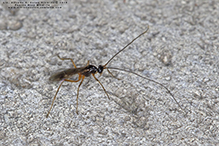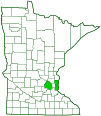braconid wasp
(Macrocentrus marginator)
Conservation • Description • Habitat • Ecology • Distribution • Taxonomy
Conservation Status |
|
|||||||
| IUCN Red List | not listed |
|||||||
| NatureServe | not listed |
|||||||
| Minnesota | not listed |
|||||||
Description |
||
Macrocentrus marginator is a small to medium-sized predatory wasp. It occurs in Europe, Siberia, Japan, and North America. It is found in a wide range of habitats, including forests, grasslands, and urban areas. Larvae are internal parasites of the caterpillars of clearwing moths (family Sesiidae). Adults are ¼″ to ⅜″ (7 to 9 mm) in length. According to one published description (Muesebeck, 1932), the abdomen and thorax are usually black but “lower part of mesopleura and the mesosternum often ferruginous.” According to BugGuide.net, “head, thorax, and abdomen black.” The head is black and slightly broader than the thorax. The back of the head (occiput) is not margined. The face is broad and pitted (punctate), and the plate on the face (clypeus) is large. The antennae are black and longer than the body, They have 41 to 49 segments; a long scape at the base, a short pedicel, and a whip-like section (flagellum) with 39 to 47 segments (flagellomeres). The first flagellomere is much longer than the scape, and the flagellomeres at the tip are long. There are two large compound eyes on the sides of the head and three small simple eyes (ocelli) in a triangle on top of the head. Compared to other members of the genus, the compound eyes are relatively medium-sized and are only slightly bulging, and the ocelli are relatively large. The finger-like sensory mouthpart (palp) attached to each lower jaw (maxilla) is conspicuously longer then the height of the head. The thorax is black and punctate above, black or sometimes rust-colored and closely punctate below. The first segment of the abdomen is constricted into a narrow petiole connecting the front part (mesosoma) and rear part (metasoma) of the body. The petiole is slightly concave below. The depression at the base of the petiole is large and deep. The rear part of the body (metasoma) is elongated, black above, and black or sometimes rust-colored below. The first two segments and sometimes also the third segment have fine longitudinal streaks, appearing as if scratched by a needle. On females, the egg-laying structure (ovipositor) protruding from the rear is a little longer than the body. The wings are slightly but not entirely transparent. The veins are dark brown. The first cubital cell is very large, at least as long as the first discoidal cell. The second discoidal cell is twice as long as its width at the end. The submedial cell is tinged smoky brown and has a conspicuous hairless patch. The stigma is dark. The legs are long, slender, and mostly brick red. The second and smallest segment (trochanter) of each leg has peg-like teeth on the outer side at the tip. On the hind leg the tip of the third segment (femur) is black, the fourth segment (tibia) is black except at the base, and the last part of the leg (tarsus), corresponding to the foot, is entirely black. The tibia has an inner spur that is 0.3 to 0.5 times the length of the first segment of the tarsus. The last segment of the tarsus has a pair of claws at the tip. Each claw has a distinct, acute, tooth-like lobe at the base. |
||
Size |
||
¼″ to ⅜″ (1 to 10 mm) long |
||
Similar Species |
||
Habitat |
||
A wide range of habitats, including forests, grasslands, and urban areas |
||
Ecology |
||
Season |
||
|
||
Behavior |
||
|
||
Life Cycle |
||
|
||
Larva Hosts |
||
Clearwing moths (family Sesiidae) |
||
Adult Food |
||
|
||
Distribution |
||||
|
Sources |
|||
| 3/28/2023 | ||||
Occurrence |
||||
|
||||
Taxonomy |
|||
Order |
Hymenoptera (Ants, Bees, Wasps, and Sawflies) | ||
Suborder |
Apocrita (Narrow-waisted Wasps, Ants, and Bees) | ||
Superfamily |
Ichneumonoidea (Ichneumonid and Braconid Wasps) | ||
Family |
Braconidae (Braconid Wasps) | ||
Subfamily |
Macrocentrinae | ||
Genus |
Macrocentrus | ||
Synonyms |
|||
Macrocentrus aegeriae |
|||
Common Names |
|||
This species has no common name. The common name of the family Braconidae is braconid wasps, and it is used here for convenience. |
|||
Glossary
Femur
On insects and arachnids, the third, largest, most robust segment of the leg, coming immediately before the tibia. On humans, the thigh bone.
Flagellomere
A segment of the whip-like third section of an insect antenna (flagellum).
Maxillae
Paired mouth structures of arthropods located immediately behind the mandible and used for tasting and manipulating food. “Under-jaws”.
Mesosoma
In Hymenoptera: the front part of the body, consisting of all three segments of the thorax and the first segment of the abdomen, to which the wings are attached.
Metasoma
In Hymenoptera: the armored rear part of the body, consisting of the second segment of the abdomen and all segments posterior to it.
Occiput
The back of the head. In Odonata, Megaloptera, and Neuroptera, the upper part of the head behind the eyes.
Ovipositor
A tube-like organ near the end of the abdomen of many female insects, used to prepare a place for an egg and to place the egg.
Palp
Short for pedipalp. A segmented, finger-like process of an arthropod; one is attached to each maxilla and two are attached to the labium. They function as sense organs in spiders and insects, and as weapons in scorpions. Plural: palpi or palps.
Petiole
On plants: The stalk of a leaf blade or a compound leaf that attaches it to the stem. On ants and wasps: The constricted first one or two segments of the rear part of the body.
Punctate
Dotted with pits (punctures), translucent sunken glands, or colored spots of pigment.
Scape
In plants: An erect, leafless stalk growing from the rootstock and supporting a flower or a flower cluster. In insects: The basal segment of the antenna.
Stigma
In plants, the portion of the female part of the flower that is receptive to pollen. In Lepidoptera, an area of specialized scent scales on the forewing of some skippers, hairstreaks, and moths. In other insects, a thickened, dark, or opaque cell on the leading edge of the wing.
Tarsus
On insects, the last two to five subdivisions of the leg, attached to the tibia; the foot. On spiders, the last segment of the leg. Plural: tarsi.
Tibia
The fourth segment of an insect leg, after the femur and before the tarsus (foot). The fifth segment of a spider leg or palp.
Visitor Photos |
|||||
Share your photo of this insect. |
|||||
| This button not working for you? Simply email us at info@MinnesotaSeasons.com. Attach one or more photos and, if you like, a caption. |
|||||
Alfredo Colon |
|||||
 |
|||||
MinnesotaSeasons.com Photos |
|||||
|
|||||

Slideshows |
||

Visitor Videos |
|||
Share your video of this insect. |
|||
| This button not working for you? Simply email us at info@MinnesotaSeasons.com. Attach a video, a YouTube link, or a cloud storage link. |
|||
Other Videos |
|||

Created: 3/28/2023
Last Updated:


